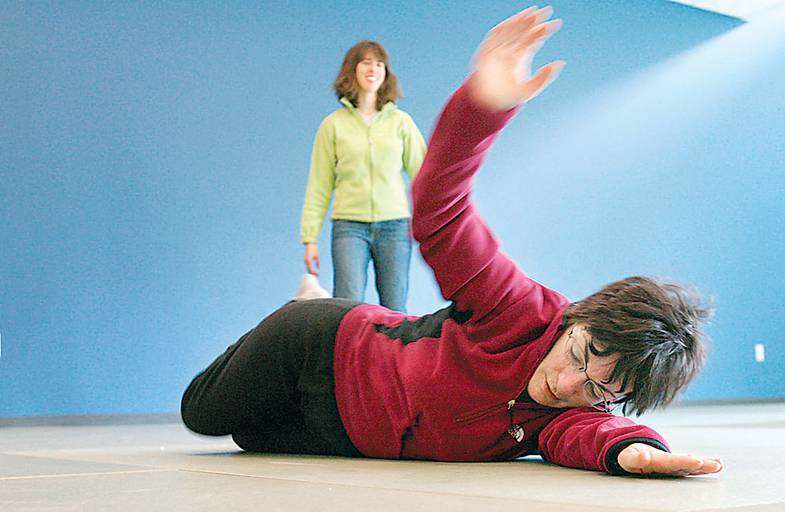Feldenkrais teaches small motions to ease tension, soothe muscles
Published 5:00 am Thursday, May 1, 2008

- Sandy Hubar, 54, of Ann Arbor, Mich., turns over using pelvic muscles during a Feldenkrais method workshop as instructor Joanna Myers, 35, watches. “I wanted to walk better. I had no idea that my posture or whole body movements would change,” Hubar says.
DETROIT — Joanna Myers is a 35-year-old professional violist in Michigan who plays with the Ann Arbor and Saginaw symphonies.
She’s also a certified Feldenkrais instructor, leading people through the very movements that helped her overcome a troubling tremor caused by tendinitis in her left hand years ago that threatened her ability to play.
“You’re experimenting with how you move,” she said. “The improvement builds with each lesson. You’re engaging in organic learning. Change happens quickly, and in an effortless way.”
Like yoga and Pilates, Feldenkrais (fell-den-KRICE) has been around for a long time. Moshe Feldenkrais, a Russian-born judo black belt, physicist, mechanical engineer and educator, first started full-time teaching of his technique to improve the way people move, think and feel in Israel in the mid-1950s.
And like yoga and Pilates did, Feldenkrais is creeping into the consciousness of American households. Every week this spring in the Detroit metro area, there are new Feldenkrais classes starting at local YMCAs, colleges, hospitals, physical therapy clinics and parks and rec departments.
“It’s definitely more popular locally,” said practitioner Joan Clarahan, 52, a physical therapy specialist at the Rehabilitation Institute of Michigan. “There are many classes. Doctors refer patients to me as a physical therapist specifically to incorporate this into their physical therapy. I think it’s one of those things that’s all of a sudden going to go big.”
Awareness through movement
Sometimes Feldenkrais classes are sneaky: they pose as courses on pain-free horseback riding, better running, a way to improve yoga form. Generic Feldenkrais classes are often called “Awareness through Movement” instead.
“Because Feldenkrais is such a strange-sounding word, people think that it’s a religion, or a cult,” said Marjorie Levine, an occupational therapist in Southfield who leads an introduction to Feldenkrais for gardeners. “It’s marketing.”
Sandy Hubar, a 54-year-old nurse and dedicated student of Myers’, first got into Feldenkrais by taking a class on ways to improve her running and walking.
“The first class I went to, it was really bizarre to me,” she said. “I was lying on the floor, making small movements that made absolutely no sense. I sat up — and my posture was a lot better. It doesn’t make sense that it’s going to work. But as you get used to it, you know what’s going to happen.
“I wanted to walk better. I had no idea that my posture or whole body movements would change.”
It’s helped her swing dancing, horseback riding, walking and sailing, she said.
“It feels really good. You feel really relaxed afterward — you sleep really well,” Hubar said. “I love yoga. Yoga’s hard. This is sooo easy.”
Gentle movements
Michele Schoel’s voice is calm and soothing.
“Sit on the edge of your chair, feet flat on the floor. Now gently turn your upper body, neck and head to the right. Stop before there is any pain, tightness or discomfort. Note the spot on the wall where your eyes have stopped.”
Schoel is a 43-year-old physical therapist and certified Feldenkrais Method practitioner from Farmington Hills, Mich. She works at the Abilities Center in Walled Lake, Mich., where she and another therapist use Feldenkrais to help children with disabilities.
She’s leading a demonstration of the method. The emphasis is on small, gentle movements done with focus and concentration, first to the right, then to the left. There is no stretching. There is no force.
“Now turn your head, eyes and shoulders to face forward. Keep your head and eyes facing forward and turn just your shoulders to the right, then back to the middle, five times. Don’t force the movement. Don’t hold your breath.”
Despite its recent successes, Feldenkrais is anything but a fad. Its instructors tend to be physical therapists, occupational therapists and massage therapists. And like Myers and Clarahan, Levine and Schoel, almost all of them got into teaching Feldenkrais because they had an injury or pain or other problem that it helped.
“Now turn your head, eyes and shoulders to the right again and see if you are turning farther than the first time. Return to facing forward.”
Schoel took the rigorous 4-year, 800-hour program to become a certified Feldenkrais instructor after the method helped her overcome pain and posture issues related to back surgery she had in her early 30s.
The key to Feldenkrais, and what sets it apart from yoga and Pilates and its more-strenuous brethren, is its total focus on how people move. While those other disciplines may ask you to work on achieving a particular pose or position, Feldenkrais is all about making tiny motions that force you to think about how you move — and force your brain to focus on those movements.
If you’ve tried Schoel’s exercise, you’re probably struck by two things: how easy it was — done properly, you should have felt no pain or tension — and how much difference there was in how far you turned before and after you tried it.
“You teach your body to move in ways it has forgotten,” Schoel said. “The idea is to get more fluid movement throughout your skeleton. As we grow, we develop movement habits. This is neurological retraining.”
On the Web
Feldenkrais videos, information and links to instructors can be found at www.feldenkrais.com.
For local contacts, see Page F10.






